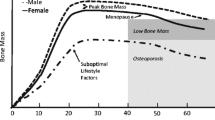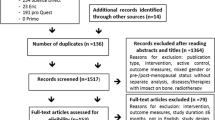Abstract
Background: Adiponectin, apelin, leptin, resistin, and visfatin, as the main circulating peptides secreted by adipose tissue, are potential contributors to bone metabolism. However, their association with bone mineral density (BMD) is unclear. Aim: The present study investigated whether these serum adipocytokines levels are associated with BMD and bone turnover markers. Methods: Serum adiponectin, apelin, leptin, resistin, visfatin levels, bone turnover biochemical markers, and BMD were determined in 336 post-menopausal Chinese women (41–81 yr old). Results: Adiponectin was negatively correlated with fat mass, while leptin had a positive correlation. In the multiple linear stepwise regression analysis, years since menopause, lean mass, estradiol, and adiponectin, but not fat mass, apelin, leptin, resistin, and visfatin, were independent predictors of BMD. The significant positive correlations between adiponectin and bone-specific alkaline phosphatase, bone cross-linked N-telopeptides of type I collagen were found. Conclusions: Adiponectin was an independent predictor of BMD in post-menopausal Chinese women, and positively correlated with bone turnover biochemical markers. It suggested that adiponectin may exert a negative effect on bone mass by promoting excessive bone resorption associated with bone loss in post-menopausal women.
Similar content being viewed by others
References
Hla MM, Davis JW, Ross PD, et al. A multicenter study of the influence of fat and lean mass on bone mineral content: evidence for differences in their relative influence at major fracture sites. Early Postmenopausal Intervention Cohort (EPIC) Study Group. Am J Clin Nutr 1996, 64: 354–60.
Maeda K, Okubo K, Shimomura I, Funahashi T, Matsuzawa Y, Matsubara K. cDNA cloning and expression of a novel adipose specific collagen-like factor, apM1 (AdiPose Most abundant Gene transcript 1). Biochem Biophys Res Commun 1996, 221: 286–9.
Luo XH, Guo LJ, Yuan LQ, et al. Adiponectin stimulates human osteoblasts proliferation and differentiation via the MAPK signaling pathway. Exp Cell Res 2005, 309: 99–109.
Luo XH, Guo LJ, Xie H, et al. Adiponectin stimulates RANKL and inhibits OPG expression in human osteoblasts through the MAPK signaling pathway. J Bone Miner Res 2006, 21: 1648–56.
Richards JB, Valdes AM, Burling K, Perks UC, Spector TD. Serum adiponectin and bone mineral density in women. J Clin Endocrinol Metab 2007, 92: 1517–23.
Huang KC, Cheng WC, Yen RF, Tsai KS, Tai TY, Yang WS. Lack of independent relationship between plasma adiponectin, leptin levels and bone density in nondiabetic female adolescents. Clin Endocrinol (Oxf) 2004, 61: 204–8.
Kontogianni MD, Dafni UG, Routsias JG, Skopouli FN. Blood leptin and adiponectin as possible mediators of the relation between fat mass and BMD in perimenopausal women. J Bone Miner Res 2004, 19: 546–51.
Thomas T, Burguera B, Melton LJ 3rd, et al. Relationship of serum leptin levels with body composition and sex steroid and insulin levels in men and women. Metabolism 2000, 49: 1278–84.
Goulding A, Taylor RW. Plasma leptin values in relation to bone mass and density and to dynamic biochemical markers of bone resorption and formation in postmenopausal women. Calcif Tissue Int 1998, 63: 456–8.
Blain H, Vuillemin A, Guillemin F, et al. Serum leptin level is a predictor of bone mineral density in postmenopausal women. J Clin Endocrinol Metab 2002, 87: 1030–5.
Odabasi E, Ozata M, Turan M, et al. Plasma leptin concentrations in postmenopausal women with osteoporosis. Eur J Endocrinol 2000, 142: 170–3.
Steppan CM, Bailey ST, Bhat S, et al. The hormone resistin links obesity to diabetes. Nature 2001, 409: 307–12.
Oh KW, Lee WY, Rhee EJ, et al. The relationship between serum resistin, leptin, adiponectin, ghrelin levels and bone mineral density in middle-aged men. Clin Endocrinol (Oxf) 2005, 63: 131–8.
Xie H, Tang SY, Cui RR, et al. Apelin and its receptor are expressed inhuman osteoblasts. Regul Pept 2006, 134: 118–25.
Tang SY, Xie H, Yuan LQ, et al. Apelin stimulates proliferation and suppresses apoptosis of mouse osteoblastic cell line MC3T3-E1 via JNK and PI3-K/Akt signaling pathways. Peptides 2007, 28: 708–18.
Xie H, Yuan LQ, Luo XH, et al. Apelin suppresses apoptosis of human osteoblasts. Apoptosis 2007, 12: 247–54.
Berndt J, Kloting N, Kralisch S, et al. Plasma visfatin concentrations and fat depot-specific mRNA expression in humans. Diabetes 2005, 54: 2911–6.
Xie H, Tang SY, Luo XH, et al. Insulin-like effects of visfatin on human osteoblasts. Calcif Tissue Int 2007, 80: 201–10.
Wu XP, Liao EY, Zhang H, Shan PF, Cao XZ, Liu SP. Establishment of BMD reference plots and determination of peak BMD at multiple skeletal regions in mainland Chinese women and the diagnosis of osteoporosis. Osteoporos Int 2004, 15: 71–9.
Liao EY, Wu XP, Deng XG, et al. Age-related bone mineral density, accumulated bone loss rate and prevalence of osteoporosis at multiple skeletal sites in chinese women. Osteoporos Int 2002, 13: 669–76.
Liao EY, Wu XP, Luo XH, et al. Establishment and evaluation of bone mineral density reference databases appropriate for diagnosis and evaluation of osteoporosis in Chinese women. J Bone Miner Metab 2003, 21: 184–92.
Jürimäe J, Jürimäe T. Adiponectin is a predictor of bone mineral density in middle-aged premenopausal women. Osteoporos Int 2007, 18: 1253–9.
Jürimäe J, Kums T, Jürimäe T. Adipocytokine and ghrelin levels in relation to bone mineral density in physically active older women: longitudinal associations. Eur J Endocrinol 2009, 160: 381–5.
Luo XH, Guo LJ, Shan PF, et al. Relationship of circulating MMP-2, MMP-1, and TIMP-1 levels with bone biochemical markers and bone mineral density in postmenopausal Chinese women. Osteoporos Int 2006, 17: 521–6.
Li S, Wagner R, Holm K, Lehotsky J, Zinaman MJ. Relationship between soft tissue body composition and bone mass in perimenopausal women. Maturitas 2004, 47: 99–105.
Jürimäe J, Jürimäe T, Leppik A, Kums T. The influence of ghrelin, adiponectin, and leptin on bone mineral density in healthy postmenopausal women. J Bone Miner Metab 2008, 26: 618–23.
Jürimäe J, Rembel K, Jürimäe T, Rehand M. Adiponectin is associated with bone mineral density in perimenopausal women. Horm Metab Res 2005, 37: 297–302.
Jürimäe J, Jürimäe T. Plasma adiponectin concentration in healthy pre- and postmenopausal women: relationship with body composition, bone mineral, and metabolic variables. Am J Physiol Endocrinol Metab 2007, 293: E42–7.
Oshima K, Nampei A, Matsuda M, et al. Adiponectin increases bone mass by suppressing osteoclast and activating osteoblast. Biochem Biophys Res Commun 2005, 331: 520–6.
Shinoda Y, Yamaguchi M, Ogata N, et al. Regulation of bone formation by adiponectin through autocrine/paracrine and endocrine pathways. J Cell Biochem 2006, 99: 196–208.
Ruhl CE, Everhart JE. Relationship of serum leptin concentration with bone mineral density in the United States population. J Bone Miner Res 2002, 17: 1896–903.
Peng XD, Xie H, Zhao Q, Wu XP, Sun ZQ, Liao EY. Relationships between serum adiponectin, leptin, resistin, visfatin levels and bone mineral density, and bone biochemical markers in Chinese men. Clin Chim Acta 2008, 387: 31–5.
Sucunza N, Barahona MJ, Resmini E, et al. A link between bone mineral density and serum adiponectin and visfatin levels in acromegaly. J Clin Endocrinol Metab 2009, 94: 3889–94.
Author information
Authors and Affiliations
Corresponding author
Rights and permissions
About this article
Cite this article
Zhang, H., Xie, H., Zhao, Q. et al. Relationships between serum adiponectin, apelin, leptin, resistin, visfatin levels and bone mineral density, and bone biochemical markers in post-menopausal Chinese women. J Endocrinol Invest 33, 707–711 (2010). https://doi.org/10.1007/BF03346674
Accepted:
Published:
Issue Date:
DOI: https://doi.org/10.1007/BF03346674




